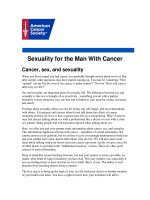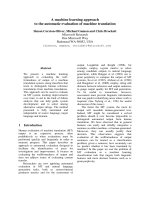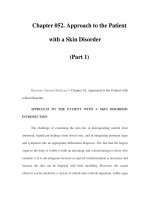Chapter 077. Approach to the Patient with Cancer (Part 11) pot
Bạn đang xem bản rút gọn của tài liệu. Xem và tải ngay bản đầy đủ của tài liệu tại đây (46.57 KB, 5 trang )
Chapter 077. Approach to the
Patient with Cancer
(Part 11)
Effusions
Fluid may accumulate abnormally in the pleural cavity, pericardium, or
peritoneum. Asymptomatic malignant effusions may not require treatment.
Symptomatic effusions occurring in tumors responsive to systemic therapy usually
do not require local treatment but respond to the treatment for the underlying
tumor. Symptomatic effusions occurring in tumors unresponsive to systemic
therapy may require local treatment in patients with a life expectancy of at least 6
months.
Pleural effusions due to tumors may or may not contain malignant cells.
Lung cancer, breast cancer, and lymphomas account for ~75% of malignant
pleural effusions. Their exudative nature is usually gauged by an effusion/serum
protein ratio of ≥0.5 or an effusion/serum lactate dehydrogenase ratio of ≥0.6.
When the condition is symptomatic, thoracentesis is usually performed first. In
most cases, symptomatic improvement occurs for <1 month. Chest tube drainage
is required if symptoms recur within 2 weeks. Fluid is aspirated until the flow rate
is <100 mL in 24 h. Then either 60 units of bleomycin or 1 g of doxycycline is
infused into the chest tube in 50 mL of 5% dextrose in water; the tube is clamped;
the patient is rotated on four sides, spending 15 min in each position; and, after 1–
2 h, the tube is again attached to suction for another 24 h. The tube is then
disconnected from suction and allowed to drain by gravity. If <100 mL drains over
the next 24 h, the chest tube is pulled, and a radiograph taken 24 h later. If the
chest tube continues to drain fluid at an unacceptably high rate, sclerosis can be
repeated. Bleomycin may be somewhat more effective than doxycycline but is
very expensive. Doxycycline is usually the drug of first choice. If neither
doxycycline nor bleomycin is effective, talc can be used.
Symptomatic pericardial effusions are usually treated by creating a
pericardial window or by stripping the pericardium. If the patient's condition does
not permit a surgical procedure, sclerosis can be attempted with doxycycline
and/or bleomycin.
Malignant ascites is usually treated with repeated paracentesis of small
volumes of fluid. If the underlying malignancy is unresponsive to systemic
therapy, peritoneovenous shunts may be inserted. Despite the fear of disseminating
tumor cells into the circulation, widespread metastases are an unusual
complication. The major complications are occlusion, leakage, and fluid overload.
Patients with severe liver disease may develop disseminated intravascular
coagulation.
Nutrition
Cancer and its treatment may lead to a decrease in nutrient intake of
sufficient magnitude to cause weight loss and alteration of intermediary
metabolism. The prevalence of this problem is difficult to estimate because of
variations in the definition of cancer cachexia, but most patients with advanced
cancer experience weight loss and decreased appetite. A variety of both tumor-
derived factors (e.g., bombesin, adrenocorticotropic hormone) and host-derived
factors (e.g., tumor necrosis factor, interleukins 1 and 6, growth hormone)
contribute to the altered metabolism, and a vicious cycle is established in which
protein catabolism, glucose intolerance, and lipolysis cannot be reversed by the
provision of calories.
It remains controversial how to assess nutritional status and when and how
to intervene. Efforts to make the assessment objective have included the use of a
prognostic nutritional index based on albumin levels, triceps skin fold thickness,
transferrin levels, and delayed-type hypersensitivity skin testing. However, a
simpler approach has been to define the threshold for nutritional intervention as
>10% unexplained body weight loss, serum transferrin level <1500 mg/L (150
mg/dL), and serum albumin <34 g/L (3.4 g/dL).
The decision is important, because it appears that cancer therapy is
substantially more toxic and less effective in the face of malnutrition.
Nevertheless, it remains unclear whether nutritional intervention can alter the
natural history. Unless some pathology is affecting the absorptive function of the
gastrointestinal tract, enteral nutrition provided orally or by tube feeding is
preferred over parenteral supplementation. However, the risks associated with the
tube may outweigh the benefits. Megestrol acetate, a progestational agent, has
been advocated as a pharmacologic intervention to improve nutritional status.
Research in this area may provide more tools in the future as cytokine-mediated
mechanisms are further elucidated.
Psychosocial Support
The psychosocial needs of patients vary with their situation. Patients
undergoing treatment experience fear, anxiety, and depression. Self-image is often
seriously compromised by deforming surgery and loss of hair. Women who
receive cosmetic advice that enables them to look better also feel better. Loss of
control over how one spends time can contribute to the sense of vulnerability.
Juggling the demands of work and family with the demands of treatment may
create enormous stresses. Sexual dysfunction is highly prevalent and needs to be
discussed openly with the patient. An empathetic health care team is sensitive to
the individual patient's needs and permits negotiation where such flexibility will
not adversely affect the course of treatment.
Cancer survivors have other sets of difficulties. Patients may have fears
associated with the termination of a treatment they associate with their continued
survival. Adjustments are required to physical losses and handicaps, real and
perceived. Patients may be preoccupied with minor physical problems. They
perceive a decline in their job mobility and view themselves as less desirable
workers. They may be victims of job and/or insurance discrimination. Patients
may experience difficulty reentering their normal past life. They may feel guilty
for having survived and may carry a sense of vulnerability to colds and other
illnesses. Perhaps the most pervasive and threatening concern is the ever-present
fear of relapse (the Damocles syndrome).
Patients in whom therapy has been unsuccessful have other problems
related to the end of life.









